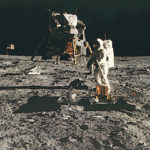IEEE Milestone: Apollo 11 Lunar Ranging Experiment
Milestone: Apollo 11 Lunar Ranging Experiment (LURE), 1969
Dedication Date: August 1, 2019
| The scientific and engineering achievement of LURE, which aimed at using lasers to precisely measure the distance between the Earth and the moon, held huge potential strategic value, both military and commercial. | The Apollo 11 Laser Ranging Retro-Reflector (LRRR) was designed by a team of scientists and engineers to serve as a reference point on the lunar surface to be used in continued monitoring of the point-to-point distances between it and stations on earth by the technique of short-pulse laser ranging. |
|
|
 |
Milestone Dedication Ceremony
This milestone was dedicated 50 years to the day from when, on August 1, 1969, Hildreth “Hal” Walker, Jr. successfully directed a laser beam, from the Lick Observatory in California, at an 18 inch wide reflector mirror on the Moon. The telescope was operated that day by research astronomer, Remington Stone. Both Walker and Stone were at Lick Observatory to celebrate this IEEE Milestone dedication.
For more information:
IEEE Milestone webpage
University of California, Santa Cruz 2009 news article
Citation
Plaque citation summarizing the achievement and its significance:
On 1 August 1969, Lick Observatory made the first Earth-to-Moon distance measurement with centimeter accuracy. The researchers fired a gigawatt ruby laser at a retro-reflector array placed on the Moon by Apollo 11 astronauts, and measured the time delay in detecting the reflected pulse. This was the first experiment using a hand-placed extraterrestrial instrument.
______________________________________________
Lick Observatory
Shane 120-inch Reflector Telescope Dome Building, on lobby wall near front entrance
7281 Mount Hamilton Road
Mount Hamilton, CA 95140

